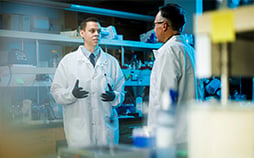Taking a Load Off
Manufacturing engineering technology student Seth Huber developed and began testing a boot to offload foot pressure so diabetics can heal from these painful sores.
February 2020

Motion capture technology—the process of recording the movements of objects and people and using that information to digitally animate characters—is used regularly in filmmaking and video game development.
But did you know it also aids biomechanical research?
With the help of a Fulton grant, master’s student Spencer Petersen is using a combination of motion capture technology and a new device that measures the forces under the foot to research the role your big toe plays in the simple act of walking.
“It’s something that has been looked at before, but not to the same depth,” he says. “With this new technology, we can measure it directly instead of estimating.”
Before pursuing his interest in biomechanics, Petersen had thought about a career in sports medicine or as a physician’s assistant. But when a passionate professor shared his infectious love for biomechanical research, Petersen was smitten.
“It’s still about the human body, but I’m learning about the forces and the physics involved,” he says. “Motion capture is an amazing data-collection method.”
Petersen hopes his research experience at BYU will help him leap into a career in the motion capture industry.

Manufacturing engineering technology student Seth Huber developed and began testing a boot to offload foot pressure so diabetics can heal from these painful sores.

BYU PhD student uses AI to expand gospel access through improved translation for more languages.

Findings from BYU researchers about using tears to diagnose diseases were recently published in Clinical Proteomics.